Cockatiel
| Cockatiel | |
|---|---|
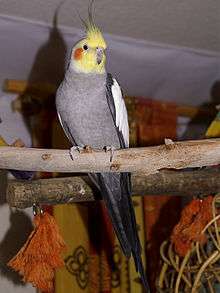 | |
| Male | |
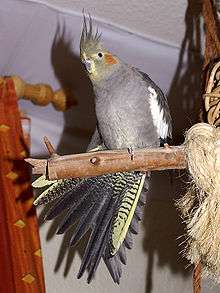 | |
| Female | |
| Scientific classification | |
| Kingdom: | Animalia |
| Phylum: | Chordata |
| Class: | Aves |
| Order: | Psittaciformes |
| Family: | Cacatuidae |
| Subfamily: | Nymphicinae |
| Genus: | Nymphicus Wagler, 1832 |
| Species: | N. hollandicus |
| Binomial name | |
| Nymphicus hollandicus (Kerr, 1792) | |
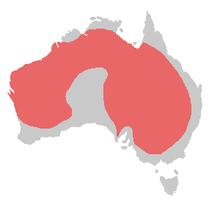 | |
| Cockatiel range (in red; all-year resident) | |
| Synonyms | |
|
Psittacus hollandicus Kerr, 1792 | |
The cockatiel (Nymphicus hollandicus), also known as the quarrion and the weiro, is a bird that is a member of the cockatoo family endemic to Australia. They are prized as household pets and companion parrots throughout the world and are relatively easy to breed. As a caged bird, cockatiels are second in popularity only to the budgerigar.[2]
The cockatiel is the only member of the genus Nymphicus. It was previously considered a crested parrot or small cockatoo; however, more recent molecular studies have assigned it to its own subfamily, Nymphicinae. It is, therefore, now classified as the smallest of the Cacatuidae (cockatoo family). Cockatiels are native to Australia, and favour the Australian wetlands, scrublands, and bush lands.
Taxonomy and etymology
Originally described by Scottish writer and naturalist Robert Kerr in 1793 as Psittacus hollandicus, the cockatiel (or cockateel) was moved to its own genus, Nymphicus, by Wagler in 1832. Its genus name reflects the experience of one of the earliest groups of Europeans to see the birds in their native habitat; the travellers thought the birds were so beautiful that they named them after mythical nymphs. The specific name hollandicus refers to New Holland, a historic name for Australia.
Its biological relationship had long been argued; it is now classified into a monotypic subfamily Nymphicinae but had sometimes in the past been misclassified among the Platycercinae, the broad-tailed parrots. This issue has now been settled with molecular studies. A 1984 study of protein allozymes signalled its closer relationship to cockatoos than to parrots,[3] and Mitochondrial 12S rRNA sequence data[4] places it amongst the Calyptorhynchinae (dark cockatoos) subfamily. The unique, parakeet (meaning long-tailed parrot) morphological feature is a consequence of the decrease in size and accompanying change of ecological niche.
Sequence analysis of intron 7 of the nuclear ?-fibrinogen gene, on the other hand, indicates that it may yet be distinct enough as to warrant recognition of the Nymphicinae rather than inclusion of the genus in the Calyptorhynchinae.[5]
The cockatiel is now biologically classified as a genuine member of Cacatuidae on account of sharing all of the cockatoo family's biological features, namely, the erectile crest, a gallbladder, powder down, suppressed cloudy-layer (which precludes the display of blue and green structural colours), and facial feathers covering the sides of the beak, all of which are rarely found outside the family Cacatuidae.
Description
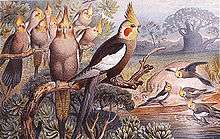
The cockatiel's distinctive erectile crest expresses the animal's emotional state. The crest is dramatically vertical when the cockatiel is startled or excited, gently oblique in its neutral or relaxed state, and flattened close to the head when the animal is angry or defensive. The crest is also held flat but protrudes outward in the back when the cockatiel is trying to appear alluring or flirtatious. In contrast to most cockatoos, the cockatiel has long tail feathers roughly making up half of its total length. At 30 to 33 cm (12 to 13 in), the cockatiel is the smallest of the cockatoos which are generally larger at between 30 and 60 cm (12 and 23.5 in).
The "normal grey" or "wild-type" cockatiel's plumage is primarily grey with prominent white flashes on the outer edges of each wing. The face of the male is yellow or white, while the face of the female is primarily grey or light grey, and both sexes feature a round orange area on both ears, often referred to as "cheddar cheeks". This orange colouration is generally vibrant in adult males, and often quite muted in females. Visual sexing is often possible with this variant of the bird.
Cockatiels are relatively vocal birds, the calls of the male being more varied than that of the female. Cockatiels can also be taught to sing specific melodies. Much like parrots, but not quite to that extent, Cockatiels can be taught to repeat words spoken by human owners.
Sexual dimorphism
All wild cockatiel chicks and juveniles look female, and are virtually indistinguishable from the time of hatching until their first moulting. They display horizontal yellow stripes or bars on the ventral surface of their tail feathers, yellow spots on the ventral surface of the primary flight feathers of their wings, a grey coloured crest and face, and a dull orange patch on each of their cheeks.
Adult cockatiels are sexually dimorphic, though to a lesser degree than many other avian species. This is only evident after the first moulting, typically occurring about six to nine months after hatching: the male loses the white or yellow barring and spots on the underside of his tail feathers and wings. The grey feathers on his cheeks and crest are replaced by bright yellow feathers, while the orange cheek patch becomes brighter and more distinct. The face and crest of the female will typically remain mostly grey, though also with an orange cheek patch. Additionally, the female commonly retains the horizontal barring on the underside of her tail feathers.
The colour in cockatiels is derived from two pigments: melanin (which provides the grey colour in the feathers, eyes, beak, and feet), and lipochromes (which provide the yellow colour on the face and tail and the orange colour of the cheek patch). The grey colour of the melanin overrides the yellow and orange of the lipochromes when both are present.
The melanin content decreases in the face of the males as they mature, allowing the yellow and orange lipochromes to be more visible, while an increase in melanin content in the tail causes the disappearance of the horizontal yellow tail bars.
In addition to these visible characteristics, the vocalization of adult males is typically louder and more complex than that of females.
Colour mutations
Fifteen different cockatiel colour mutations are currently established in aviculture, including grey, pied, pearled, cinnamon, whitefaced, lutino, albino (a.k.a. whitefaced lutino) and yellowcheeked cockatiels. Mutations in captivity have emerged in various colours, some quite different from those observed in nature. In 1949 the species began to spread throughout the world, with the creation of "wild", and then "pied" mutation developed in California in the United States. There are many mutations of cockatiels with varied colours, they are: silvestre, harlequin, lutino, cinnamon, opaline (pearl), cara black, silver, fawn, albino (there is a pattern and not just albino genetic mutations), pastel, silver and recessive silver dominant.
Distribution and habitat
 |
Cockatiel calling
Recording of a cockatiel |
| Problems playing this file? See media help. | |
Cockatiels are native to Australia, where they are found largely in arid or semi-arid country, but always close to water. Largely nomadic, the species will move to where food and water is available.[2] They are typically seen in pairs or small flocks.[2] Sometimes, hundreds will flock around a single body of water. To many farmers' dismay, they often eat cultivated crops. They are absent from the most fertile south west and south east corners of the country, the deepest Western Australian deserts, and Cape York Peninsula. They are the only cockatoo species which can sometimes reproduce in the end of their first year.
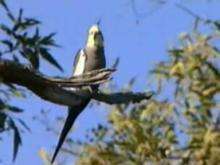
Life span
The cockatiel's lifespan in captivity is generally given as 16 to 25 years,[6] though it is sometimes given as short as 10 to 15 years, and there are reports of cockatiels living as long as 32 years, the oldest confirmed specimen reported being 36 years old.[7] Diet and exercise are major determining factors.
Gallery
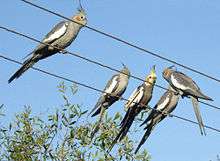 Wild cockatiels
Wild cockatiels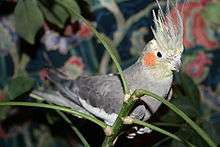 A wild type (natural grey coloured) cockatiel showing excitement or interest by its erected crest
A wild type (natural grey coloured) cockatiel showing excitement or interest by its erected crest Male cockatiels
Male cockatiels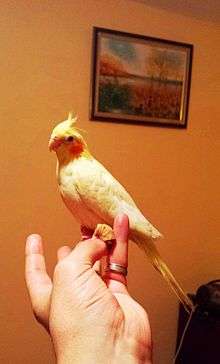 A pet lutino cockatiel on the hand of its companion
A pet lutino cockatiel on the hand of its companion A young pet ADMpied cockatiel
A young pet ADMpied cockatiel Nearly-completely clear (notice the small grey coloured feathers near the edge of its wing) ADMpied cockatiel
Nearly-completely clear (notice the small grey coloured feathers near the edge of its wing) ADMpied cockatiel Three-week-old whiteface lutino cockatiel chick
Three-week-old whiteface lutino cockatiel chick One-day-old cockatiel chick
One-day-old cockatiel chick Cockatiel plumage glowing under a blacklight
Cockatiel plumage glowing under a blacklight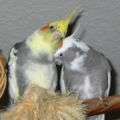 Cockatiels are social birds
Cockatiels are social birds Male grey cockatiel
Male grey cockatiel- Female grey cockatiel
.jpg) Male Pied cockatiel
Male Pied cockatiel Female Lutino cockatiel contrasted by flowers in the background.
Female Lutino cockatiel contrasted by flowers in the background.
See also
References
- ↑ BirdLife International (2012). "Nymphicus hollandicus". IUCN Red List of Threatened Species. Version 2013.2. International Union for Conservation of Nature. Retrieved 26 November 2013.
- 1 2 3 "Factsheets:Cockatiel". Australian Museum. Retrieved 2008-08-30.
- ↑ Adams, M; Baverstock, PR; Saunders, DA; Schodde, R; Smith, GT (1984). "Biochemical systematics of the Australian cockatoos (Psittaciformes: Cacatuinae)". Australian Journal of Zoology. 32 (3): 363–77. doi:10.1071/ZO9840363.
- ↑ Brown, D.M. & Toft, C.A. (1999): Molecular systematics and biogeography of the cockatoos (Psittaciformes: Cacatuidae). Auk 116(1): 141-157. JSTOR 4089461
- ↑ Astuti, Dwi (2004): A phylogeny of Cockatoos (Aves: Psittaciformes) inferred from DNA sequences of the seventh intron of Nuclear ?-fibrinogen gene. Doctoral work, Graduate School of Environmental Earth Science, Hokkaido University, Japan.
- ↑ cockatielcottage.net
- ↑ Brouwer, K.; Jones, M.L.; King, C.E. & Schifter, H. (2000). "Longevity records for Psittaciformes in captivity". International Zoo Yearbook. 37 (1): 299–316. doi:10.1111/j.1748-1090.2000.tb00735.x.
Further reading
- Astuti, Dwi (2004?): A phylogeny of cockatoos (Aves: Psittaciformes) inferred from DNA sequences of the seventh intron of nuclear β-fibrinogen gene. Doctoral work, Graduate School of Environmental Earth Science, Hokkaido University, Japan. PDF fulltext
- Flegg, Jim (2002): Photographic Field Guide: Birds of Australia. Reed New Holland, Sydney & London. ISBN 1-876334-78-9
- Martin, Terry (2002). A Guide To Colour Mutations and Genetics in Parrots. ABK Publications. ISBN 0-9577024-6-9.
- Hayward, Jim (1992). The Manual of Colour Breeding. The Aviculturist Publications. ISBN 0-9519098-0-0.
External links
| Wikispecies has information related to: Nymphicus hollandicus |
- Cockatiels at DMOZ
- Inte Onsman's MUTAVI Research & Advice Group
- Cockatiels – National Cockatiel Society
- Cockatiel Information Forum and Bulletin Board – Talk Cockatiels
- Videos, images and sounds – Internet Bird Collection
